MBA501: Disruptive Innovation and Strategic Leadership Analysis
VerifiedAdded on 2022/10/12
|12
|1462
|472
Project
AI Summary
This assignment analyzes the implications of dynamic strategy and disruptive innovation techniques, focusing on a case study of Essendon Food Solutions (EFS). It examines both internal perspectives, including human resources, organizational culture, resource allocation, and organizational structure, and external aspects such as regulations and commitments. The analysis considers EFS's challenges in adapting to disruptive innovation, including issues with traditional business programs, resistance within the organizational culture, and resource allocation. The marketing and technological perspectives are also evaluated, highlighting the absence of a structured marketing team and the age of the R&D team. The paper references key literature on disruptive innovation, strategic leadership, and business model innovation to provide a comprehensive overview of the topic.
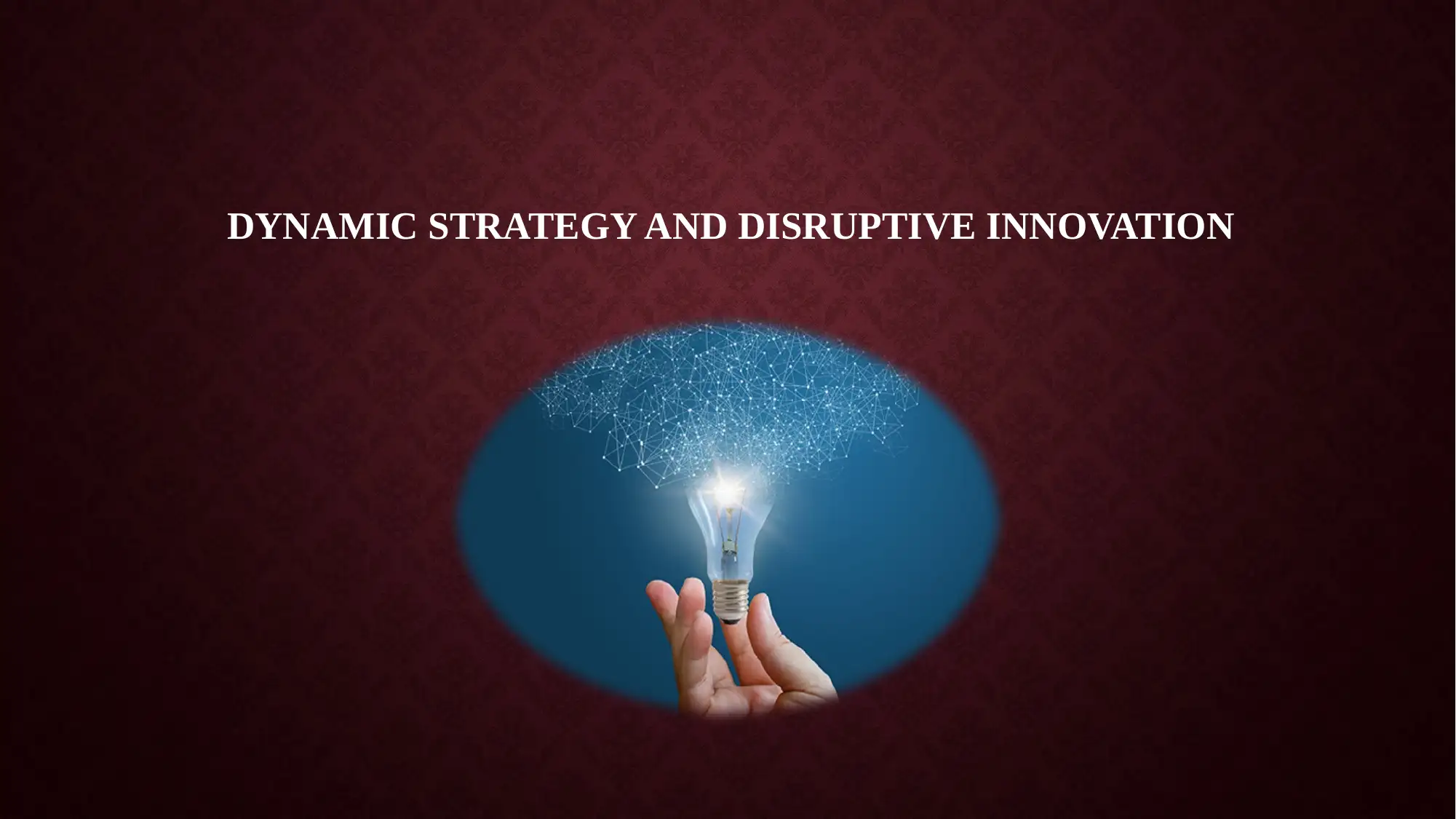
DYNAMIC STRATEGY AND DISRUPTIVE INNOVATION
Paraphrase This Document
Need a fresh take? Get an instant paraphrase of this document with our AI Paraphraser
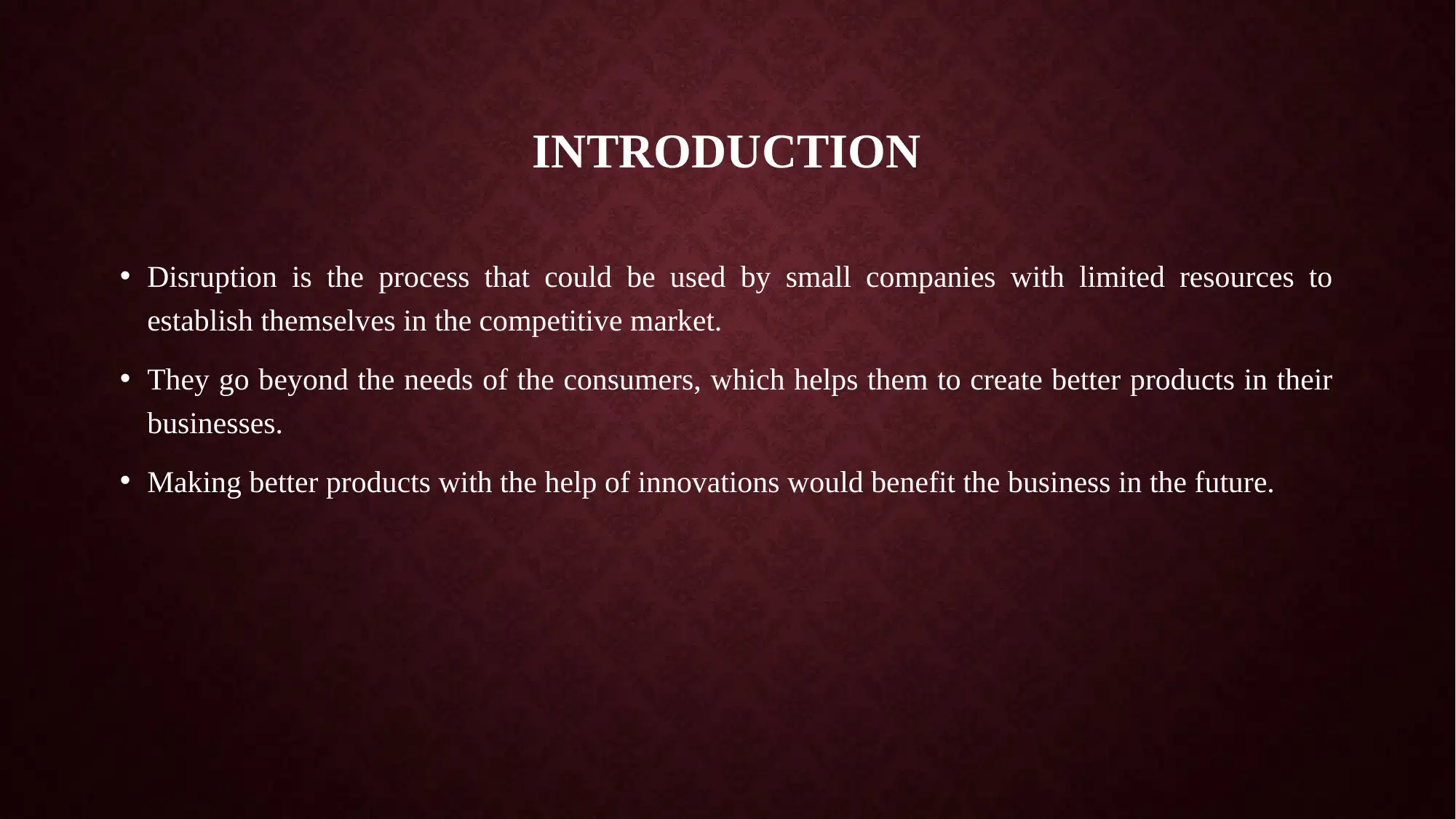
INTRODUCTION
• Disruption is the process that could be used by small companies with limited resources to
establish themselves in the competitive market.
• They go beyond the needs of the consumers, which helps them to create better products in their
businesses.
• Making better products with the help of innovations would benefit the business in the future.
• Disruption is the process that could be used by small companies with limited resources to
establish themselves in the competitive market.
• They go beyond the needs of the consumers, which helps them to create better products in their
businesses.
• Making better products with the help of innovations would benefit the business in the future.
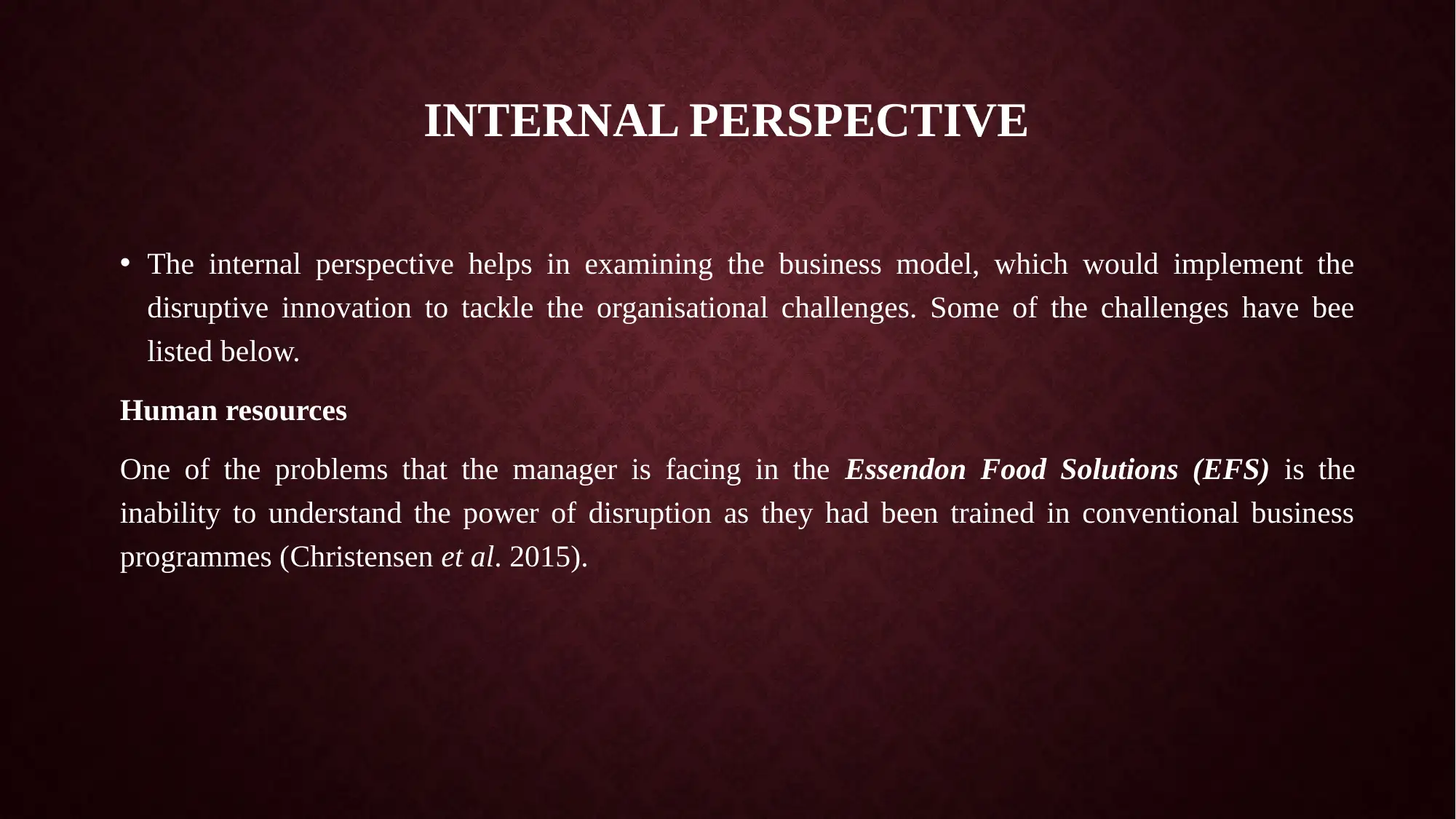
INTERNAL PERSPECTIVE
• The internal perspective helps in examining the business model, which would implement the
disruptive innovation to tackle the organisational challenges. Some of the challenges have bee
listed below.
Human resources
One of the problems that the manager is facing in the Essendon Food Solutions (EFS) is the
inability to understand the power of disruption as they had been trained in conventional business
programmes (Christensen et al. 2015).
• The internal perspective helps in examining the business model, which would implement the
disruptive innovation to tackle the organisational challenges. Some of the challenges have bee
listed below.
Human resources
One of the problems that the manager is facing in the Essendon Food Solutions (EFS) is the
inability to understand the power of disruption as they had been trained in conventional business
programmes (Christensen et al. 2015).
⊘ This is a preview!⊘
Do you want full access?
Subscribe today to unlock all pages.

Trusted by 1+ million students worldwide
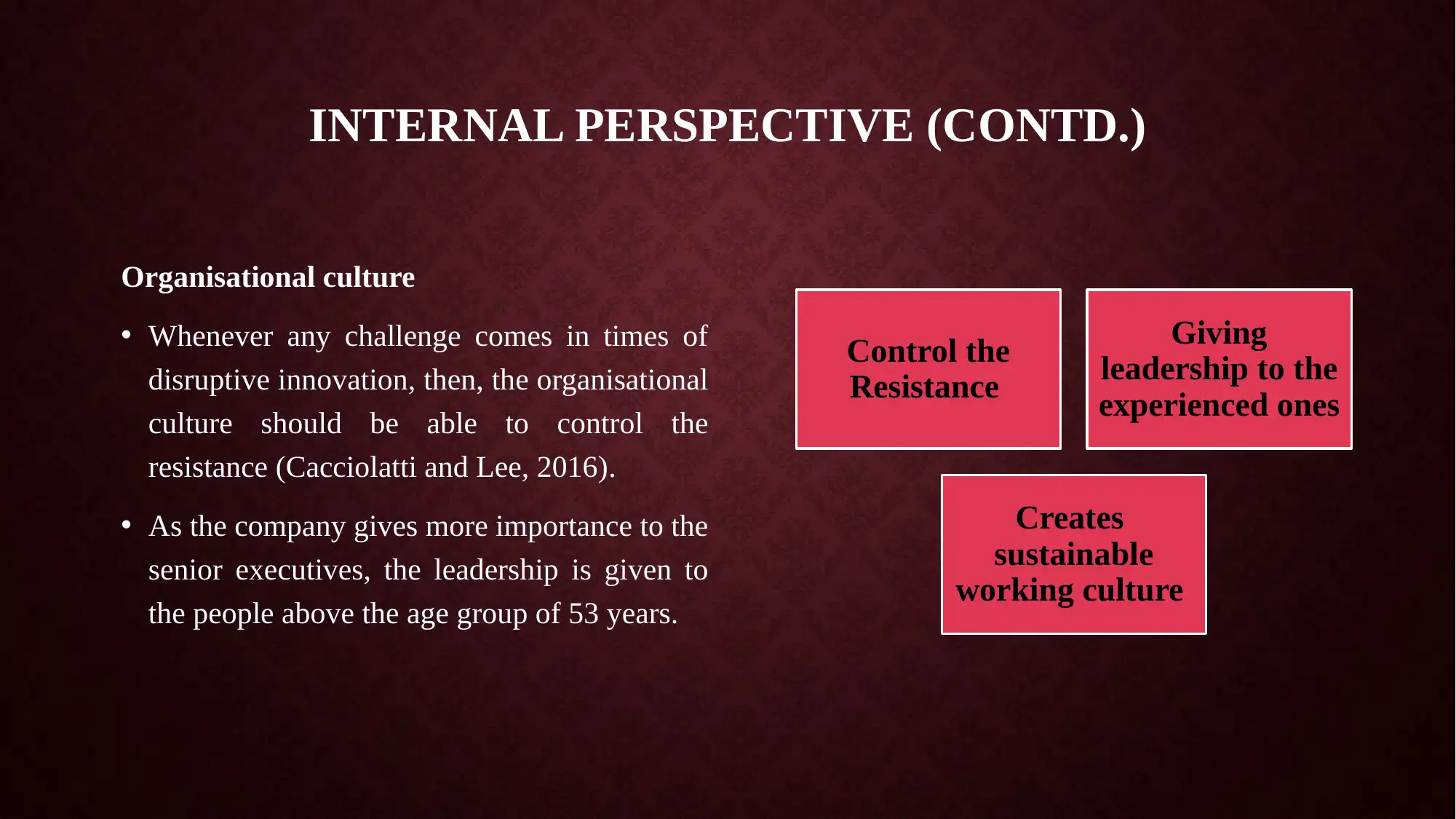
INTERNAL PERSPECTIVE (CONTD.)
Organisational culture
• Whenever any challenge comes in times of
disruptive innovation, then, the organisational
culture should be able to control the
resistance (Cacciolatti and Lee, 2016).
• As the company gives more importance to the
senior executives, the leadership is given to
the people above the age group of 53 years.
Control the
Resistance
Giving
leadership to the
experienced ones
Creates
sustainable
working culture
Organisational culture
• Whenever any challenge comes in times of
disruptive innovation, then, the organisational
culture should be able to control the
resistance (Cacciolatti and Lee, 2016).
• As the company gives more importance to the
senior executives, the leadership is given to
the people above the age group of 53 years.
Control the
Resistance
Giving
leadership to the
experienced ones
Creates
sustainable
working culture
Paraphrase This Document
Need a fresh take? Get an instant paraphrase of this document with our AI Paraphraser
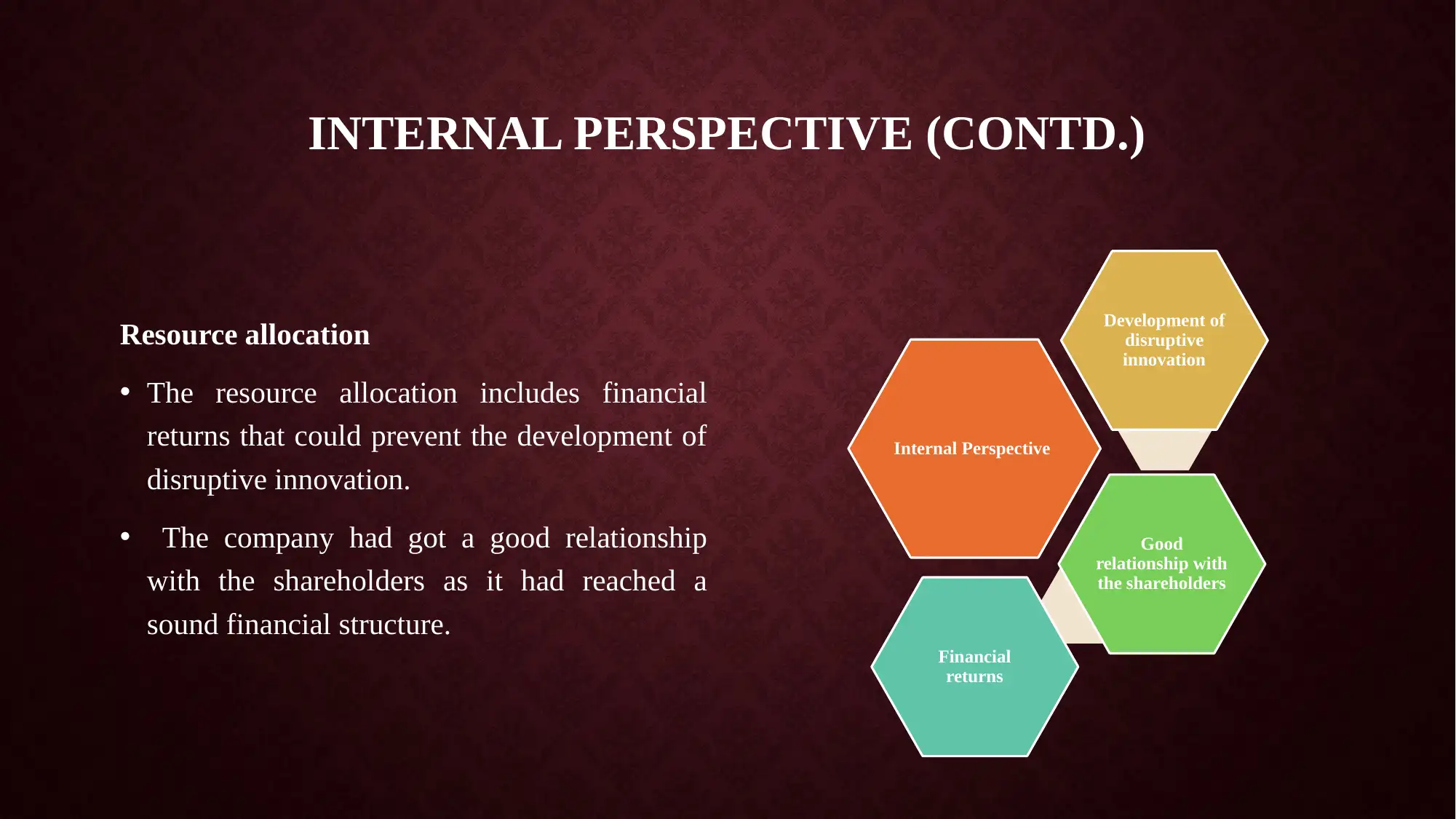
INTERNAL PERSPECTIVE (CONTD.)
Resource allocation
• The resource allocation includes financial
returns that could prevent the development of
disruptive innovation.
• The company had got a good relationship
with the shareholders as it had reached a
sound financial structure.
Internal Perspective
Development of
disruptive
innovation
Good
relationship with
the shareholders
Financial
returns
Resource allocation
• The resource allocation includes financial
returns that could prevent the development of
disruptive innovation.
• The company had got a good relationship
with the shareholders as it had reached a
sound financial structure.
Internal Perspective
Development of
disruptive
innovation
Good
relationship with
the shareholders
Financial
returns
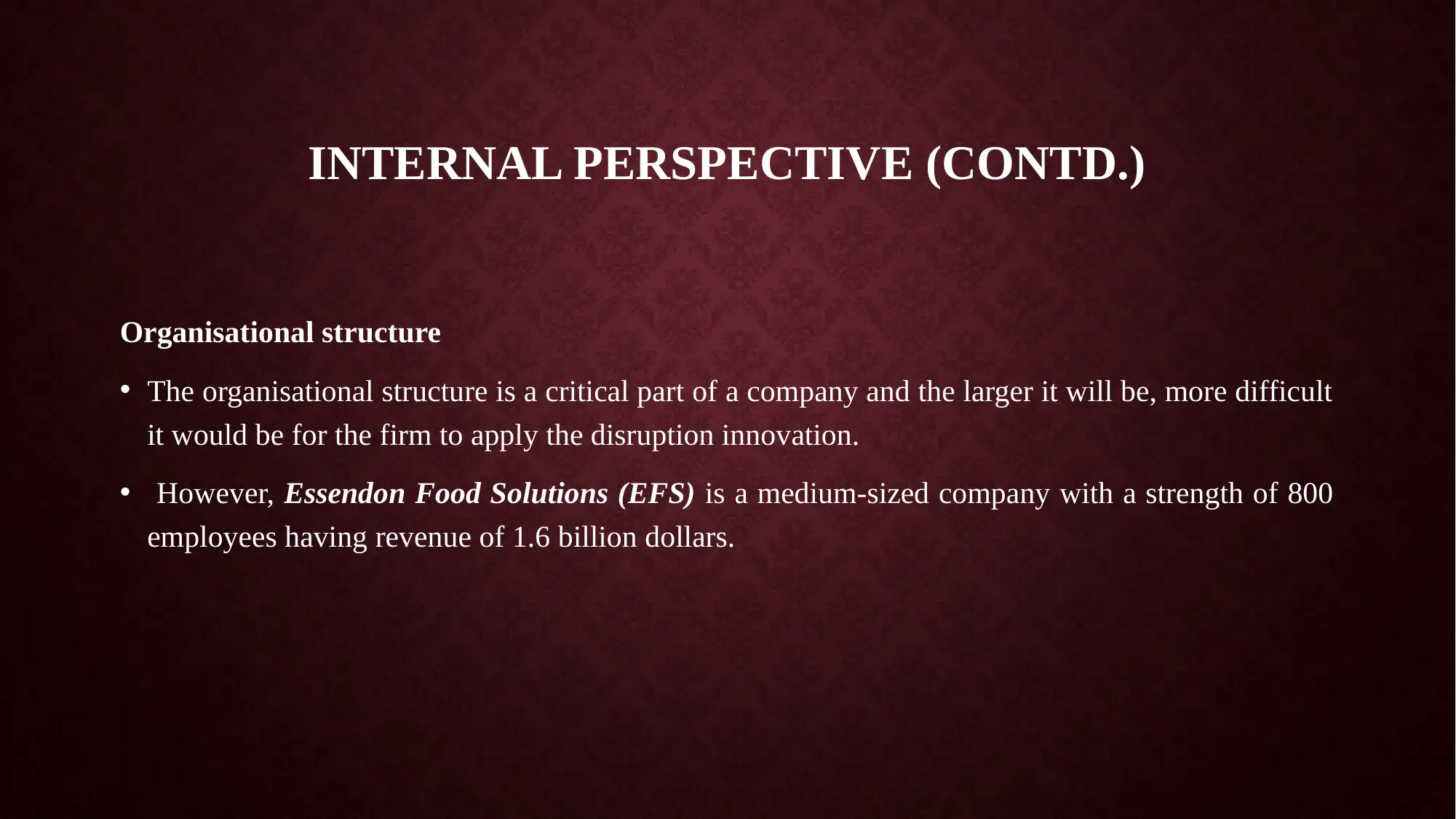
INTERNAL PERSPECTIVE (CONTD.)
Organisational structure
• The organisational structure is a critical part of a company and the larger it will be, more difficult
it would be for the firm to apply the disruption innovation.
• However, Essendon Food Solutions (EFS) is a medium-sized company with a strength of 800
employees having revenue of 1.6 billion dollars.
Organisational structure
• The organisational structure is a critical part of a company and the larger it will be, more difficult
it would be for the firm to apply the disruption innovation.
• However, Essendon Food Solutions (EFS) is a medium-sized company with a strength of 800
employees having revenue of 1.6 billion dollars.
⊘ This is a preview!⊘
Do you want full access?
Subscribe today to unlock all pages.

Trusted by 1+ million students worldwide
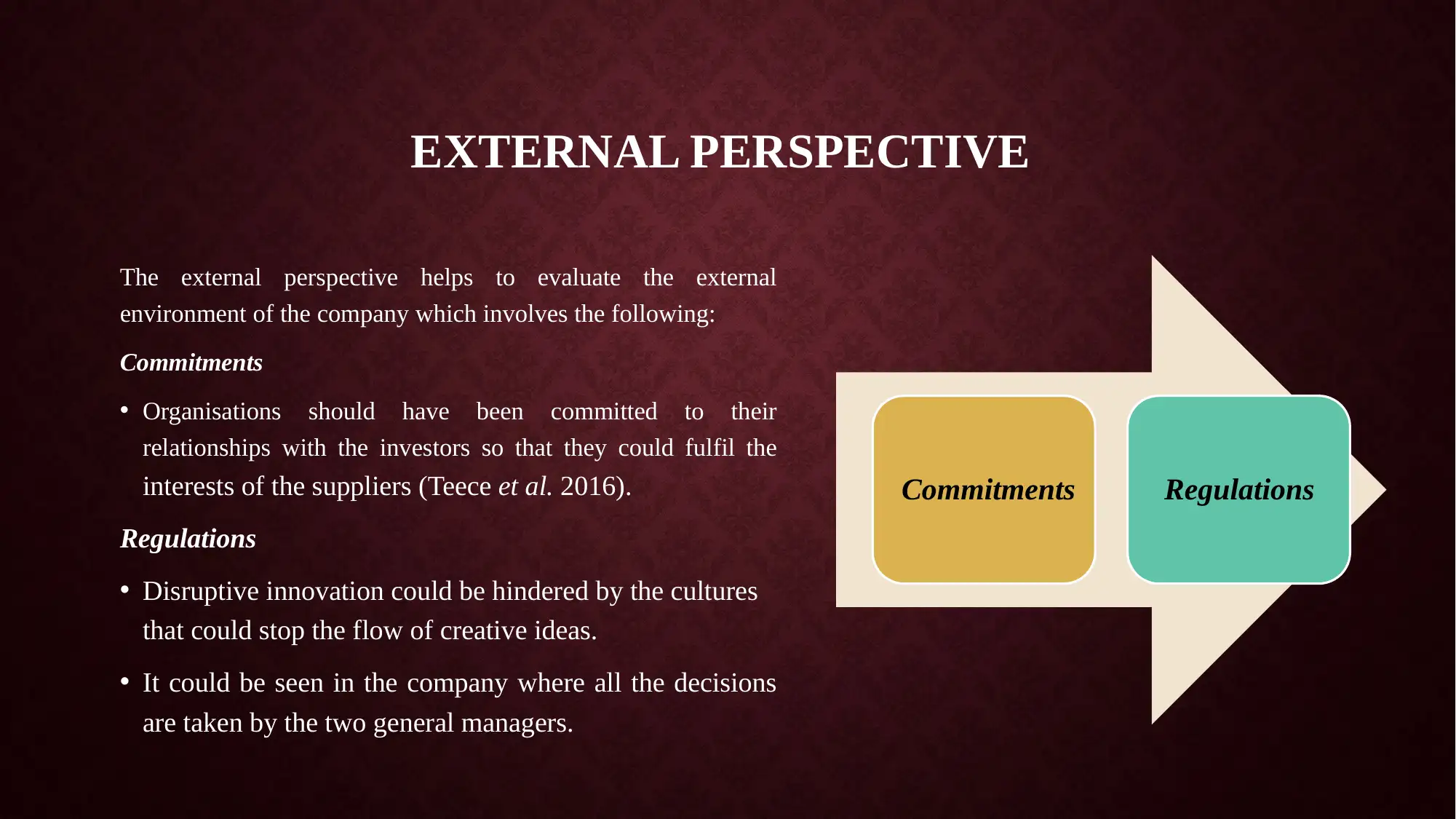
EXTERNAL PERSPECTIVE
The external perspective helps to evaluate the external
environment of the company which involves the following:
Commitments
• Organisations should have been committed to their
relationships with the investors so that they could fulfil the
interests of the suppliers (Teece et al. 2016).
Regulations
• Disruptive innovation could be hindered by the cultures
that could stop the flow of creative ideas.
• It could be seen in the company where all the decisions
are taken by the two general managers.
Commitments Regulations
The external perspective helps to evaluate the external
environment of the company which involves the following:
Commitments
• Organisations should have been committed to their
relationships with the investors so that they could fulfil the
interests of the suppliers (Teece et al. 2016).
Regulations
• Disruptive innovation could be hindered by the cultures
that could stop the flow of creative ideas.
• It could be seen in the company where all the decisions
are taken by the two general managers.
Commitments Regulations
Paraphrase This Document
Need a fresh take? Get an instant paraphrase of this document with our AI Paraphraser
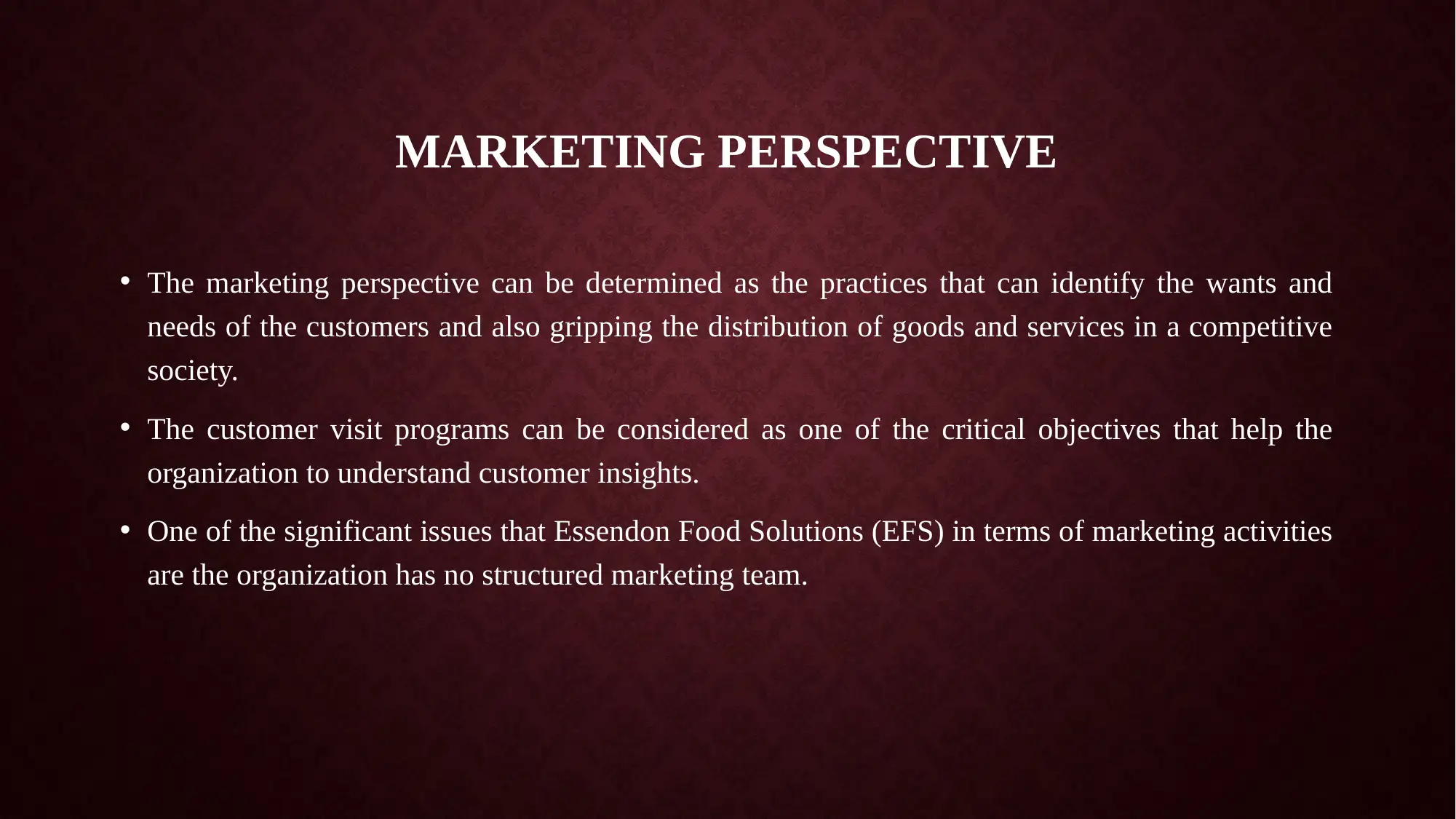
MARKETING PERSPECTIVE
• The marketing perspective can be determined as the practices that can identify the wants and
needs of the customers and also gripping the distribution of goods and services in a competitive
society.
• The customer visit programs can be considered as one of the critical objectives that help the
organization to understand customer insights.
• One of the significant issues that Essendon Food Solutions (EFS) in terms of marketing activities
are the organization has no structured marketing team.
• The marketing perspective can be determined as the practices that can identify the wants and
needs of the customers and also gripping the distribution of goods and services in a competitive
society.
• The customer visit programs can be considered as one of the critical objectives that help the
organization to understand customer insights.
• One of the significant issues that Essendon Food Solutions (EFS) in terms of marketing activities
are the organization has no structured marketing team.
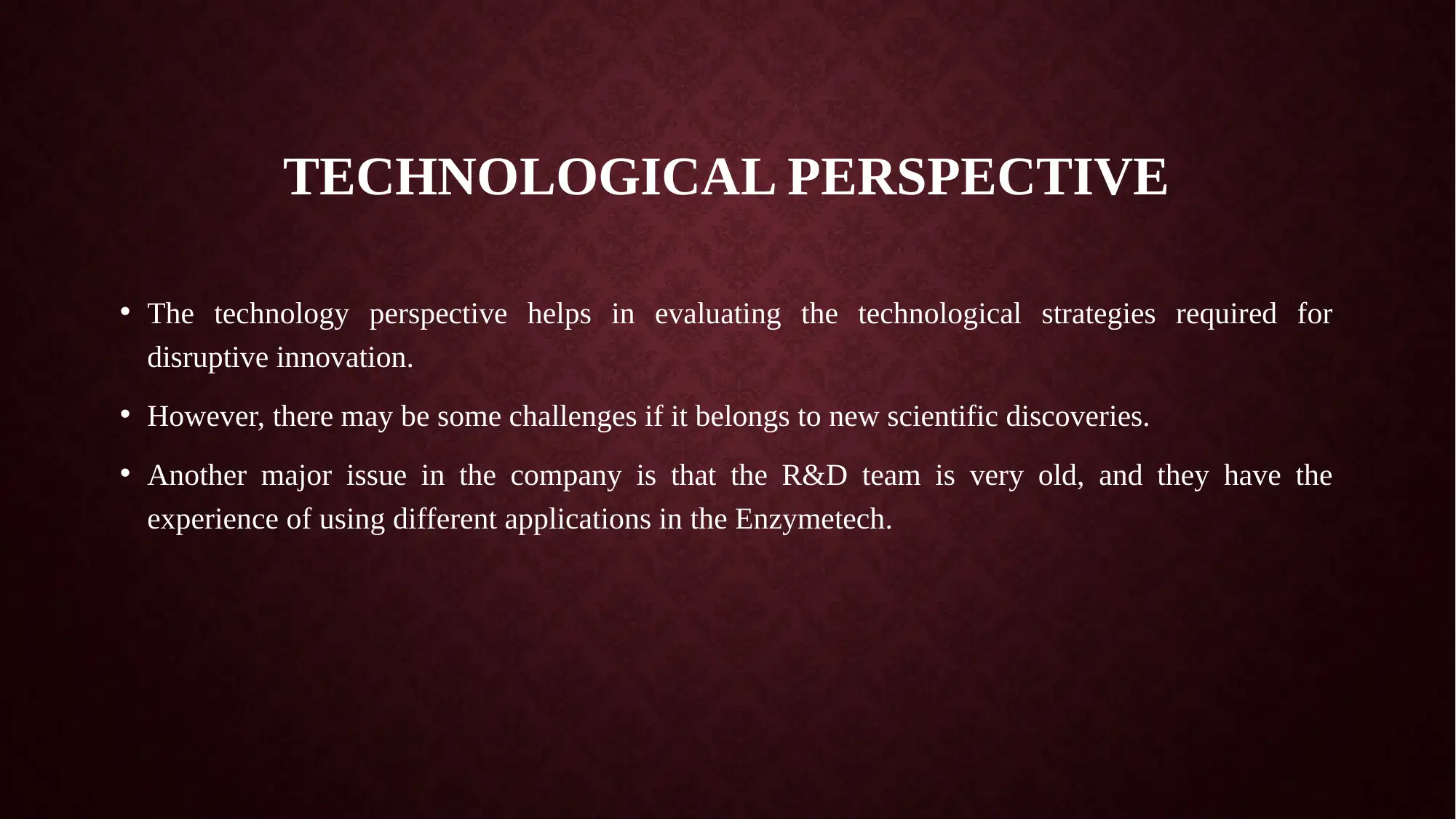
TECHNOLOGICAL PERSPECTIVE
• The technology perspective helps in evaluating the technological strategies required for
disruptive innovation.
• However, there may be some challenges if it belongs to new scientific discoveries.
• Another major issue in the company is that the R&D team is very old, and they have the
experience of using different applications in the Enzymetech.
• The technology perspective helps in evaluating the technological strategies required for
disruptive innovation.
• However, there may be some challenges if it belongs to new scientific discoveries.
• Another major issue in the company is that the R&D team is very old, and they have the
experience of using different applications in the Enzymetech.
⊘ This is a preview!⊘
Do you want full access?
Subscribe today to unlock all pages.

Trusted by 1+ million students worldwide
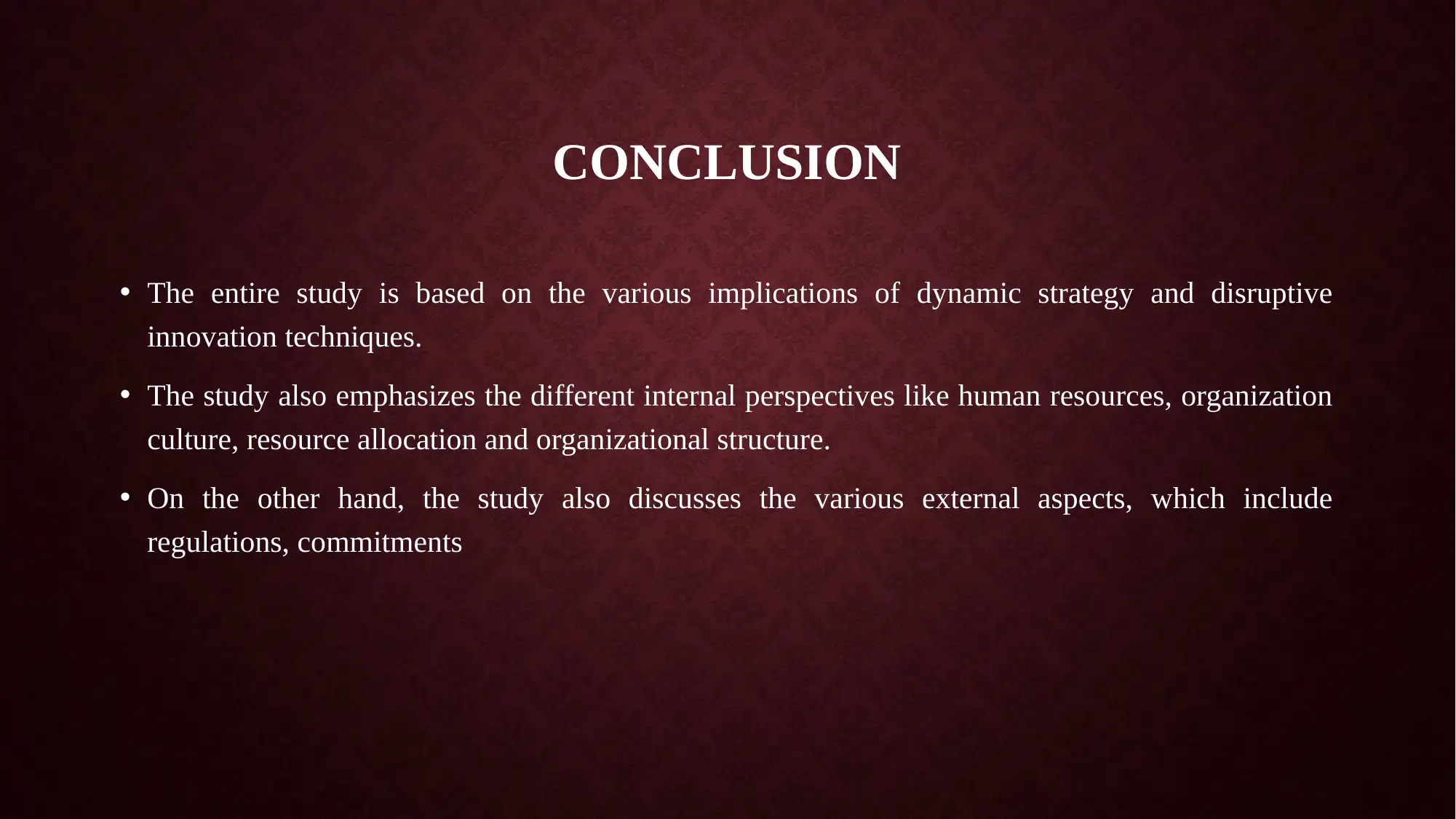
CONCLUSION
• The entire study is based on the various implications of dynamic strategy and disruptive
innovation techniques.
• The study also emphasizes the different internal perspectives like human resources, organization
culture, resource allocation and organizational structure.
• On the other hand, the study also discusses the various external aspects, which include
regulations, commitments
• The entire study is based on the various implications of dynamic strategy and disruptive
innovation techniques.
• The study also emphasizes the different internal perspectives like human resources, organization
culture, resource allocation and organizational structure.
• On the other hand, the study also discusses the various external aspects, which include
regulations, commitments
Paraphrase This Document
Need a fresh take? Get an instant paraphrase of this document with our AI Paraphraser
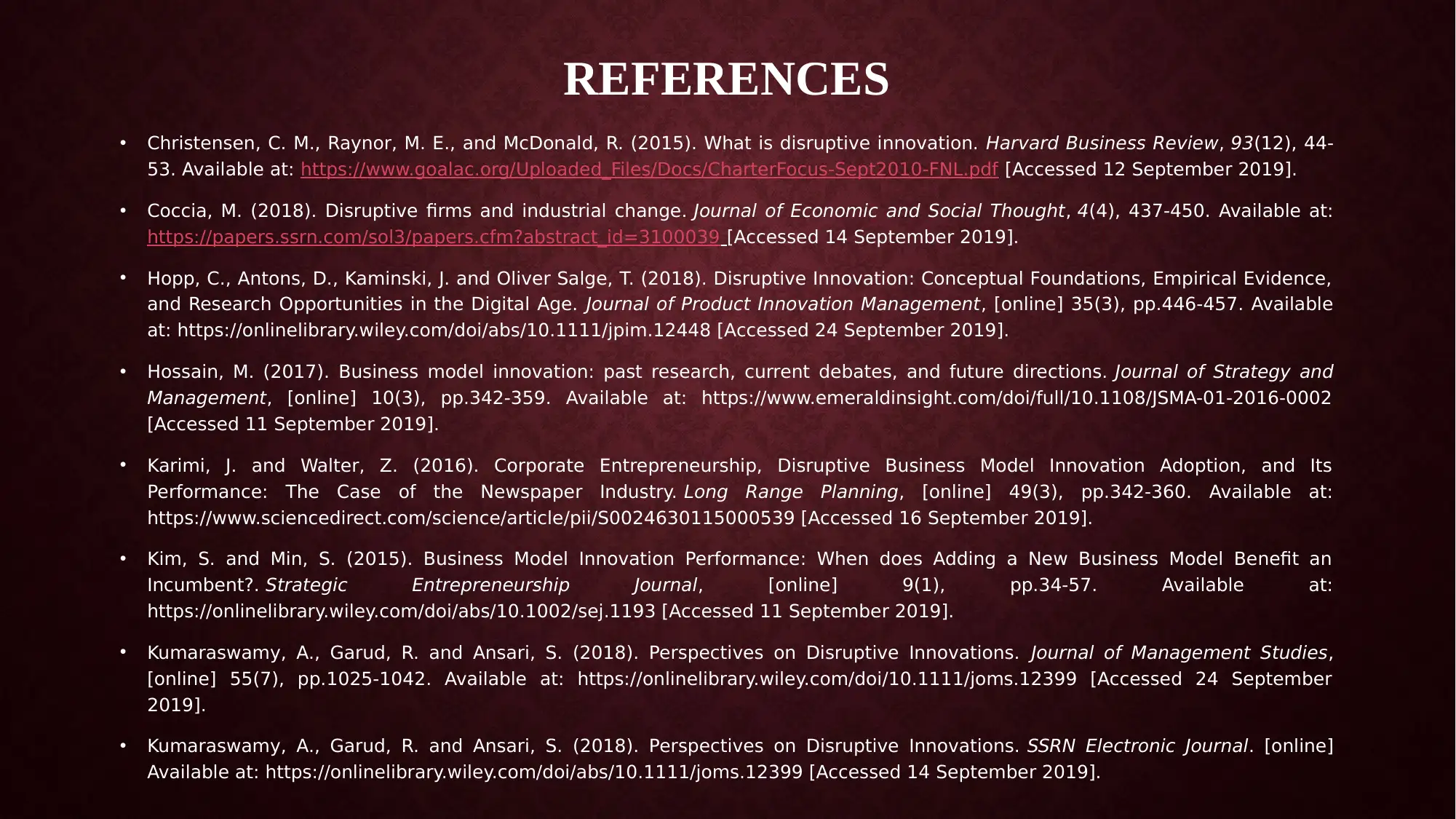
REFERENCES
• Christensen, C. M., Raynor, M. E., and McDonald, R. (2015). What is disruptive innovation. Harvard Business Review, 93(12), 44-
53. Available at: https://www.goalac.org/Uploaded_Files/Docs/CharterFocus-Sept2010-FNL.pdf [Accessed 12 September 2019].
• Coccia, M. (2018). Disruptive firms and industrial change. Journal of Economic and Social Thought, 4(4), 437-450. Available at:
https://papers.ssrn.com/sol3/papers.cfm?abstract_id=3100039 [Accessed 14 September 2019].
• Hopp, C., Antons, D., Kaminski, J. and Oliver Salge, T. (2018). Disruptive Innovation: Conceptual Foundations, Empirical Evidence,
and Research Opportunities in the Digital Age. Journal of Product Innovation Management, [online] 35(3), pp.446-457. Available
at: https://onlinelibrary.wiley.com/doi/abs/10.1111/jpim.12448 [Accessed 24 September 2019].
• Hossain, M. (2017). Business model innovation: past research, current debates, and future directions. Journal of Strategy and
Management, [online] 10(3), pp.342-359. Available at: https://www.emeraldinsight.com/doi/full/10.1108/JSMA-01-2016-0002
[Accessed 11 September 2019].
• Karimi, J. and Walter, Z. (2016). Corporate Entrepreneurship, Disruptive Business Model Innovation Adoption, and Its
Performance: The Case of the Newspaper Industry. Long Range Planning, [online] 49(3), pp.342-360. Available at:
https://www.sciencedirect.com/science/article/pii/S0024630115000539 [Accessed 16 September 2019].
• Kim, S. and Min, S. (2015). Business Model Innovation Performance: When does Adding a New Business Model Benefit an
Incumbent?. Strategic Entrepreneurship Journal, [online] 9(1), pp.34-57. Available at:
https://onlinelibrary.wiley.com/doi/abs/10.1002/sej.1193 [Accessed 11 September 2019].
• Kumaraswamy, A., Garud, R. and Ansari, S. (2018). Perspectives on Disruptive Innovations. Journal of Management Studies,
[online] 55(7), pp.1025-1042. Available at: https://onlinelibrary.wiley.com/doi/10.1111/joms.12399 [Accessed 24 September
2019].
• Kumaraswamy, A., Garud, R. and Ansari, S. (2018). Perspectives on Disruptive Innovations. SSRN Electronic Journal. [online]
Available at: https://onlinelibrary.wiley.com/doi/abs/10.1111/joms.12399 [Accessed 14 September 2019].
• Christensen, C. M., Raynor, M. E., and McDonald, R. (2015). What is disruptive innovation. Harvard Business Review, 93(12), 44-
53. Available at: https://www.goalac.org/Uploaded_Files/Docs/CharterFocus-Sept2010-FNL.pdf [Accessed 12 September 2019].
• Coccia, M. (2018). Disruptive firms and industrial change. Journal of Economic and Social Thought, 4(4), 437-450. Available at:
https://papers.ssrn.com/sol3/papers.cfm?abstract_id=3100039 [Accessed 14 September 2019].
• Hopp, C., Antons, D., Kaminski, J. and Oliver Salge, T. (2018). Disruptive Innovation: Conceptual Foundations, Empirical Evidence,
and Research Opportunities in the Digital Age. Journal of Product Innovation Management, [online] 35(3), pp.446-457. Available
at: https://onlinelibrary.wiley.com/doi/abs/10.1111/jpim.12448 [Accessed 24 September 2019].
• Hossain, M. (2017). Business model innovation: past research, current debates, and future directions. Journal of Strategy and
Management, [online] 10(3), pp.342-359. Available at: https://www.emeraldinsight.com/doi/full/10.1108/JSMA-01-2016-0002
[Accessed 11 September 2019].
• Karimi, J. and Walter, Z. (2016). Corporate Entrepreneurship, Disruptive Business Model Innovation Adoption, and Its
Performance: The Case of the Newspaper Industry. Long Range Planning, [online] 49(3), pp.342-360. Available at:
https://www.sciencedirect.com/science/article/pii/S0024630115000539 [Accessed 16 September 2019].
• Kim, S. and Min, S. (2015). Business Model Innovation Performance: When does Adding a New Business Model Benefit an
Incumbent?. Strategic Entrepreneurship Journal, [online] 9(1), pp.34-57. Available at:
https://onlinelibrary.wiley.com/doi/abs/10.1002/sej.1193 [Accessed 11 September 2019].
• Kumaraswamy, A., Garud, R. and Ansari, S. (2018). Perspectives on Disruptive Innovations. Journal of Management Studies,
[online] 55(7), pp.1025-1042. Available at: https://onlinelibrary.wiley.com/doi/10.1111/joms.12399 [Accessed 24 September
2019].
• Kumaraswamy, A., Garud, R. and Ansari, S. (2018). Perspectives on Disruptive Innovations. SSRN Electronic Journal. [online]
Available at: https://onlinelibrary.wiley.com/doi/abs/10.1111/joms.12399 [Accessed 14 September 2019].
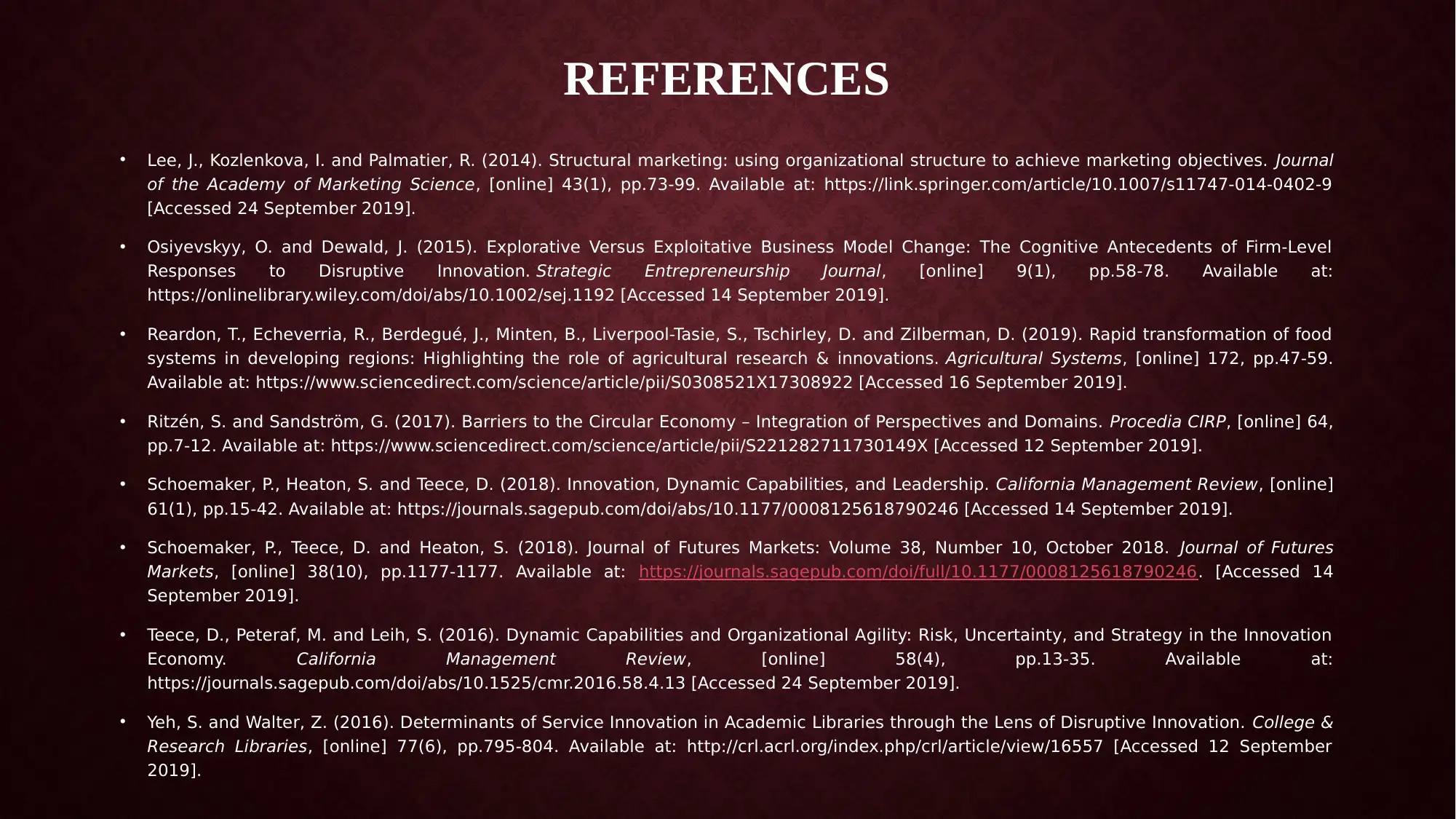
REFERENCES
• Lee, J., Kozlenkova, I. and Palmatier, R. (2014). Structural marketing: using organizational structure to achieve marketing objectives. Journal
of the Academy of Marketing Science, [online] 43(1), pp.73-99. Available at: https://link.springer.com/article/10.1007/s11747-014-0402-9
[Accessed 24 September 2019].
• Osiyevskyy, O. and Dewald, J. (2015). Explorative Versus Exploitative Business Model Change: The Cognitive Antecedents of Firm-Level
Responses to Disruptive Innovation. Strategic Entrepreneurship Journal, [online] 9(1), pp.58-78. Available at:
https://onlinelibrary.wiley.com/doi/abs/10.1002/sej.1192 [Accessed 14 September 2019].
• Reardon, T., Echeverria, R., Berdegué, J., Minten, B., Liverpool-Tasie, S., Tschirley, D. and Zilberman, D. (2019). Rapid transformation of food
systems in developing regions: Highlighting the role of agricultural research & innovations. Agricultural Systems, [online] 172, pp.47-59.
Available at: https://www.sciencedirect.com/science/article/pii/S0308521X17308922 [Accessed 16 September 2019].
• Ritzén, S. and Sandström, G. (2017). Barriers to the Circular Economy – Integration of Perspectives and Domains. Procedia CIRP, [online] 64,
pp.7-12. Available at: https://www.sciencedirect.com/science/article/pii/S221282711730149X [Accessed 12 September 2019].
• Schoemaker, P., Heaton, S. and Teece, D. (2018). Innovation, Dynamic Capabilities, and Leadership. California Management Review, [online]
61(1), pp.15-42. Available at: https://journals.sagepub.com/doi/abs/10.1177/0008125618790246 [Accessed 14 September 2019].
• Schoemaker, P., Teece, D. and Heaton, S. (2018). Journal of Futures Markets: Volume 38, Number 10, October 2018. Journal of Futures
Markets, [online] 38(10), pp.1177-1177. Available at: https://journals.sagepub.com/doi/full/10.1177/0008125618790246. [Accessed 14
September 2019].
• Teece, D., Peteraf, M. and Leih, S. (2016). Dynamic Capabilities and Organizational Agility: Risk, Uncertainty, and Strategy in the Innovation
Economy. California Management Review, [online] 58(4), pp.13-35. Available at:
https://journals.sagepub.com/doi/abs/10.1525/cmr.2016.58.4.13 [Accessed 24 September 2019].
• Yeh, S. and Walter, Z. (2016). Determinants of Service Innovation in Academic Libraries through the Lens of Disruptive Innovation. College &
Research Libraries, [online] 77(6), pp.795-804. Available at: http://crl.acrl.org/index.php/crl/article/view/16557 [Accessed 12 September
2019].
• Lee, J., Kozlenkova, I. and Palmatier, R. (2014). Structural marketing: using organizational structure to achieve marketing objectives. Journal
of the Academy of Marketing Science, [online] 43(1), pp.73-99. Available at: https://link.springer.com/article/10.1007/s11747-014-0402-9
[Accessed 24 September 2019].
• Osiyevskyy, O. and Dewald, J. (2015). Explorative Versus Exploitative Business Model Change: The Cognitive Antecedents of Firm-Level
Responses to Disruptive Innovation. Strategic Entrepreneurship Journal, [online] 9(1), pp.58-78. Available at:
https://onlinelibrary.wiley.com/doi/abs/10.1002/sej.1192 [Accessed 14 September 2019].
• Reardon, T., Echeverria, R., Berdegué, J., Minten, B., Liverpool-Tasie, S., Tschirley, D. and Zilberman, D. (2019). Rapid transformation of food
systems in developing regions: Highlighting the role of agricultural research & innovations. Agricultural Systems, [online] 172, pp.47-59.
Available at: https://www.sciencedirect.com/science/article/pii/S0308521X17308922 [Accessed 16 September 2019].
• Ritzén, S. and Sandström, G. (2017). Barriers to the Circular Economy – Integration of Perspectives and Domains. Procedia CIRP, [online] 64,
pp.7-12. Available at: https://www.sciencedirect.com/science/article/pii/S221282711730149X [Accessed 12 September 2019].
• Schoemaker, P., Heaton, S. and Teece, D. (2018). Innovation, Dynamic Capabilities, and Leadership. California Management Review, [online]
61(1), pp.15-42. Available at: https://journals.sagepub.com/doi/abs/10.1177/0008125618790246 [Accessed 14 September 2019].
• Schoemaker, P., Teece, D. and Heaton, S. (2018). Journal of Futures Markets: Volume 38, Number 10, October 2018. Journal of Futures
Markets, [online] 38(10), pp.1177-1177. Available at: https://journals.sagepub.com/doi/full/10.1177/0008125618790246. [Accessed 14
September 2019].
• Teece, D., Peteraf, M. and Leih, S. (2016). Dynamic Capabilities and Organizational Agility: Risk, Uncertainty, and Strategy in the Innovation
Economy. California Management Review, [online] 58(4), pp.13-35. Available at:
https://journals.sagepub.com/doi/abs/10.1525/cmr.2016.58.4.13 [Accessed 24 September 2019].
• Yeh, S. and Walter, Z. (2016). Determinants of Service Innovation in Academic Libraries through the Lens of Disruptive Innovation. College &
Research Libraries, [online] 77(6), pp.795-804. Available at: http://crl.acrl.org/index.php/crl/article/view/16557 [Accessed 12 September
2019].
⊘ This is a preview!⊘
Do you want full access?
Subscribe today to unlock all pages.

Trusted by 1+ million students worldwide
1 out of 12
Related Documents
Your All-in-One AI-Powered Toolkit for Academic Success.
+13062052269
info@desklib.com
Available 24*7 on WhatsApp / Email
![[object Object]](/_next/static/media/star-bottom.7253800d.svg)
Unlock your academic potential
Copyright © 2020–2025 A2Z Services. All Rights Reserved. Developed and managed by ZUCOL.





